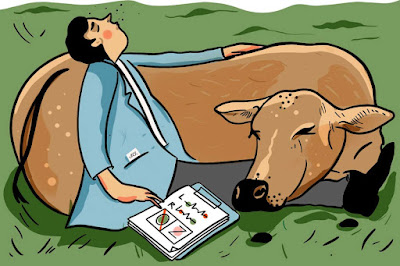Downer's Cow Syndrome (Cow unable to stand up)
The most likely reason for a cow go down is trauma. This could be post-calving, a metabolic issue (such as milk fever) or a disease such as mastitis or metritis.
The initial cause of the downer cow will be resolved, yet the animal still won't stand. This failure to rise is usually observed within 24 hours of the cow going down, as a result of muscle and nerve damage.This damage occurs because a cow going off its feet results in heavy pressure on its muscles and nerves, this is made worse in many diseases by the cow being unable to shift position to prevent continuous bearing of weight.
Treatment
Downer cows are often hypocalcemic. If an apparently hypocalcemic cow does not respond to calcium therapy, phosphorus, magnesium, and potassium should be given as additional treatments pending the results of laboratory tests. Monitoring the blood mineral status is an important part of downer cow management.
In most cases, recovery depends on the quality of recumbency management and nursing care. Lateral recumbency must be corrected immediately to avoid regurgitation and inspiration of stomach contents.
The animal should be rolled into sternal recumbency. However, if this posture is to be maintained, the limb on which the animal has been lying should be drawn from under the body. In other words, if the animal was presented in lateral recumbency on its left side, it should be rolled into sternal recumbency on its right side. Support (eg, straw bale) placed under the shoulder may be required for some animals to maintain sternal recumbency.
Attempting to stabilize a recumbent cow on a concrete surface is highly undesirable but sometimes unavoidable. Bedding the area around and under the cow with wet, sticky manure to a depth about 6 inches is a common practice. At least 10 inches. of dry straw should be distributed over the wet mass. If the cow struggles and scrapes the wet manure, exposing concrete, more manure must be added.
The so-called manure pack provides good footing but also may soil the skin with urine and manure. Dermatitis can result, and comfort of the cow is reduced.
More seriously, the risk of mastitis resulting from the contaminated environment is very high. A bed of sand 10 inches. deep is more effective. This usually drains well, and good hygiene can be maintained if the manure is removed several times each day.
Tags:
Dairy Farming

